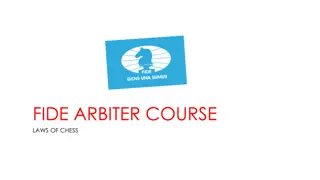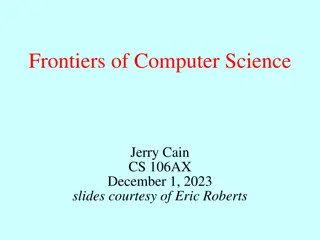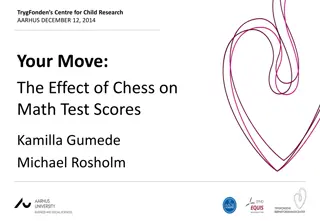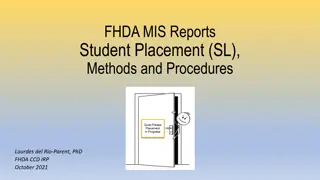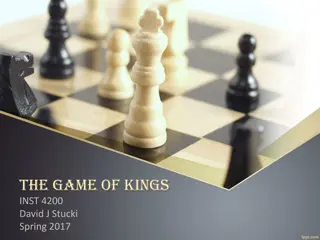Exploring Chess Board Placement with Queens
In this discussion, we delve into the strategic placement of queens on an NxN chess board to avoid attacks. By employing recursion and a 1D array, we explore efficient methods for successful queen placements while maintaining board integrity.
Download Presentation

Please find below an Image/Link to download the presentation.
The content on the website is provided AS IS for your information and personal use only. It may not be sold, licensed, or shared on other websites without obtaining consent from the author.If you encounter any issues during the download, it is possible that the publisher has removed the file from their server.
You are allowed to download the files provided on this website for personal or commercial use, subject to the condition that they are used lawfully. All files are the property of their respective owners.
The content on the website is provided AS IS for your information and personal use only. It may not be sold, licensed, or shared on other websites without obtaining consent from the author.
E N D
Presentation Transcript
What did we talk about last time? Finished Tower of Hanoi Merge sort
Given an Nx Nchess board, where N 4 it is possible to place Nqueens on the board so that none of them are able to attack each other in a given move Write a method that, given a value of N, will return the total number of ways that the Nqueens can be placed
We will use recursion to place queens on the board, one row at a time To save typing, we will use a loop to place the queen at each different column within the row and then recurse Egad! A loop inside recursion! It happens. If we have placed queens on all the rows, we return 1 (a successful placement) We sum up all the successful placements that our recursive children make
We can never have more than one queen in a given row Instead of using a 2D array, we can just use a 1D array The array will record which column a queen on a given row uses Thus, it will be an array of int values The array for the placement to the right would look like: {3, 6, 2, 7, 1, 4, 0, 5}
Base case: (row= 8) You have placed queens on rows 0-7 Return 1 (a successful placement) Recursive case: (row< 8) Keep a sum of the successful placements made by placing in future rows, initially 0 Try to place a queen on columns 0-7 For each successful column placement, recursively try to place queens on the next row and add those successful placements to your sum Return sum
As you place a queen on a row, you'll need a method to check if it's safe If it isn't safe, there's no reason to recurse We have set up our program so that no queens can ever be on the same row We still have to check previous rows to see if they have the same column or diagonal Checking the column simply means seeing if the number inside the row is the same Checking the diagonal requires more thought Use a method with the following signature, where board is the 1D array of int values giving column locations and rowis the row you're currently adding to public static boolean isSafe(int[] board, int row) You only need to look at the locations before row
At the end of COMP 1600, we briefly mentioned general file I/O Think of a file as a stream of bytes It's possible to read data from and write data to files Files are great because they exist after the program is done executing Reading from and writing to text files is very similar to reading and writing to the command line (using Scanner and System.out)
First, we're going to talk about text files All files are sequences of bytes stored in binary, but in text files, those bytes form human-readable text like words and numbers Unlike files storing data in binary, working with text files is similar to the command-line I/O we've been doing since before COMP 2000 Examples of text files: Source code for most programming languages (.c, .java, .py files, etc.) Plain text files (often with a .txt extension) Many configuration and log files
File extensions have no real meaning Extensions are part of the name of a file A file filled with binary data could end in .txt An audio file could end with .jpg The OS uses extensions to guess about which program should open a file Changing the extension changes nothing about a file Caveat:I've heard that changing an image or audio file extension in macOSwill sometimes change the format of the file In Windows, you should never hide extensions, since doing so allows the OS to lie to you about the file's real name
Reading from a text file is straightforward We use Scanner, just like reading from the command line We just have to create a new File object that gives the file path we want to read from Scanner in = new Scanner(new File("input.txt")); This code will read from some file called input.txt, as if someone were typing its contents into the command line
Recall that we can read correctly formatted text with a Scanner using the following methods nextInt() Reads an int value nextDouble() Reads a double value next() Reads a white-space delimited String nextLine() Reads a String up to the next newline (which can cause problems if there's a newline left over from previous reads) These methods are usually what you need to get the job done, but there are also nextBoolean(), nextByte(), nextFloat(), nextLong(), and nextShort() methods Note that all the integer reading methods have a second version that takes a base so that you can read values in bases 2-36
When a Scanner is reading from the keyboard, it has no idea what the user will type next However, when a Scanner is reading from a file, it can examine the text it hasn't read yet A number of methods are available to tell you if there's some properly formatted data just ahead waiting to be read: hasNextInt() There's an int waiting to be read hasNextDouble() There's a double waiting to be read hasNext() There's a String waiting to be read hasNextLine() There's a line waiting to be read Such methods are often used in a while loop to keep reading data until the end of the file is reached
Writing files Examples Error handling
Start Project 3 Form teams immediately! Keep reading Chapter 20







